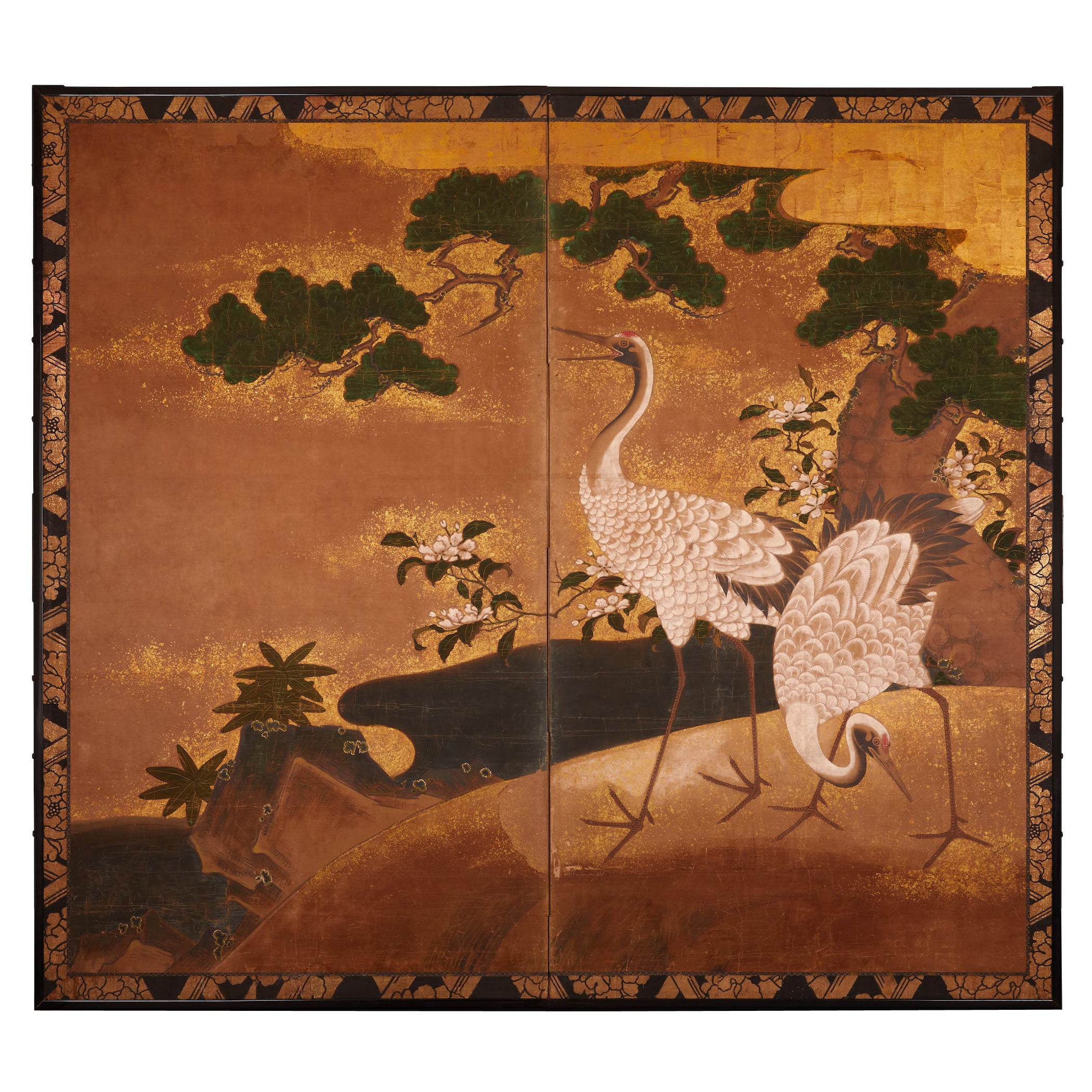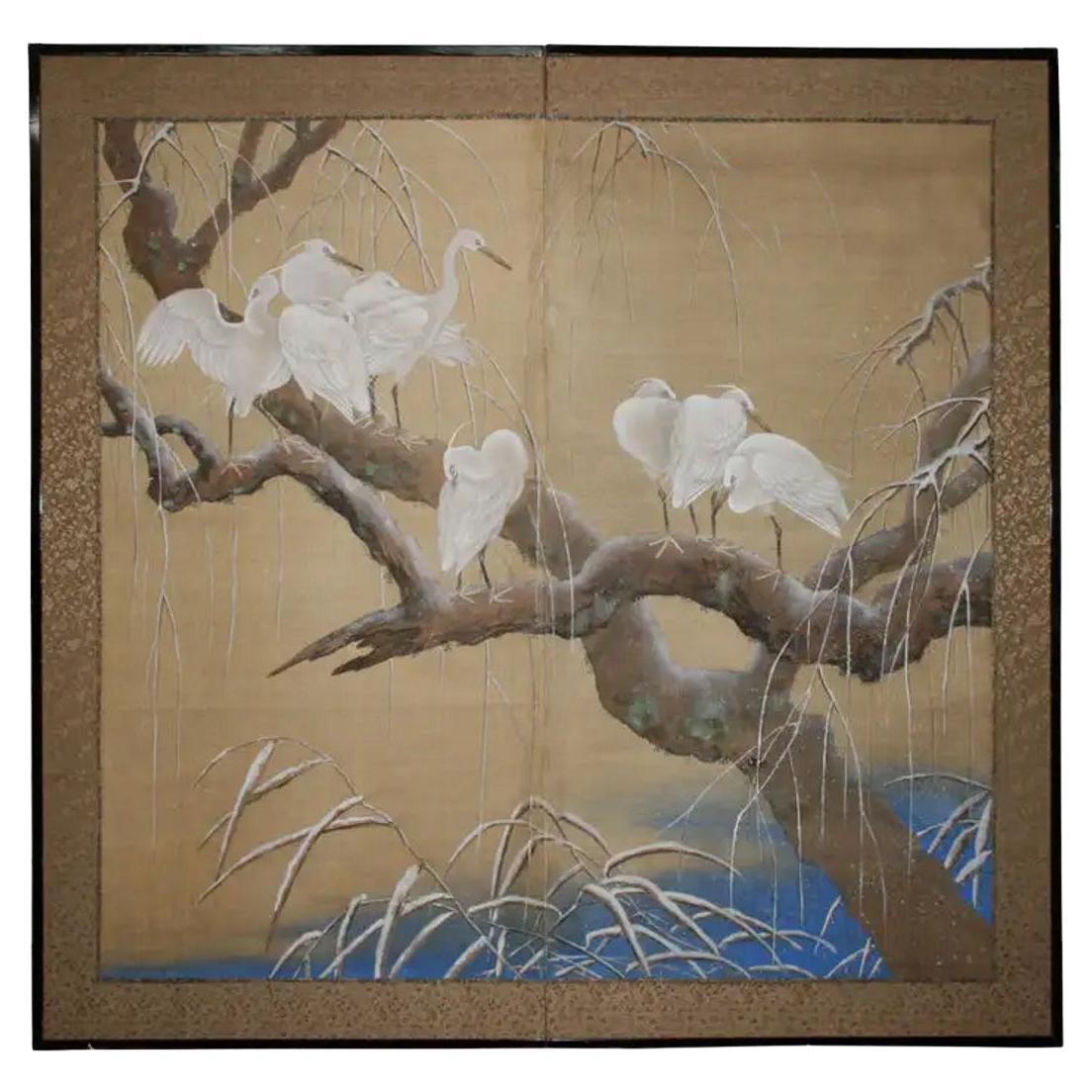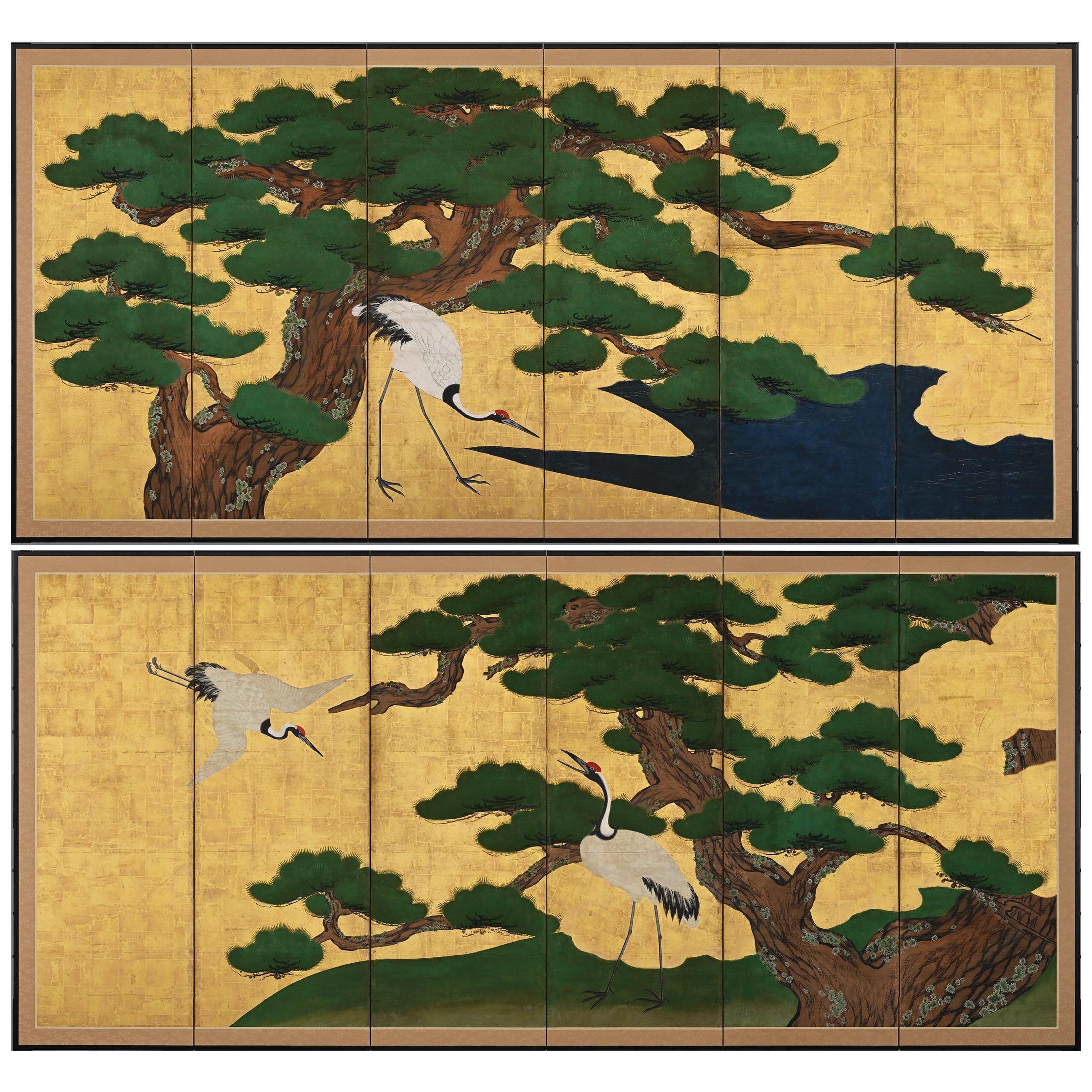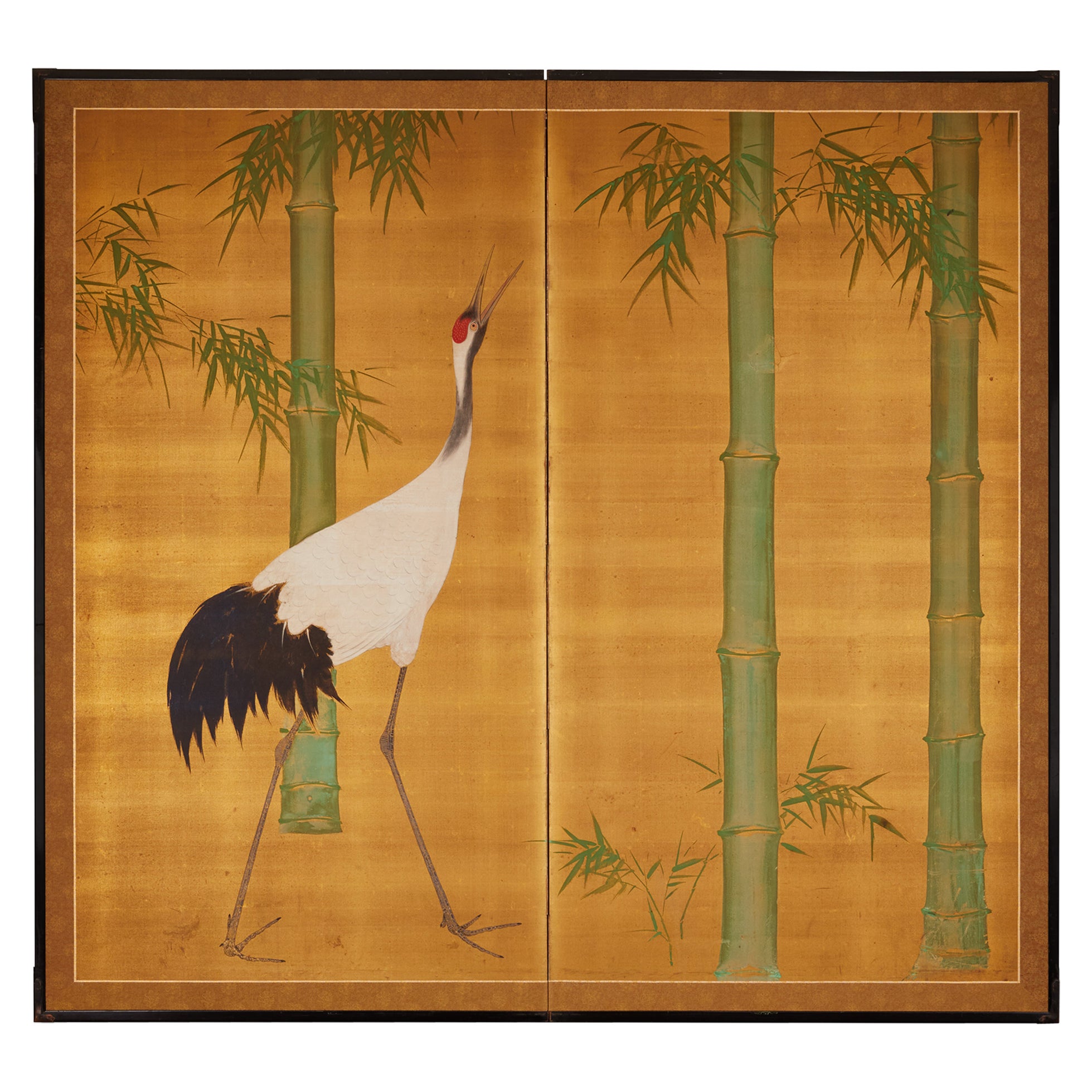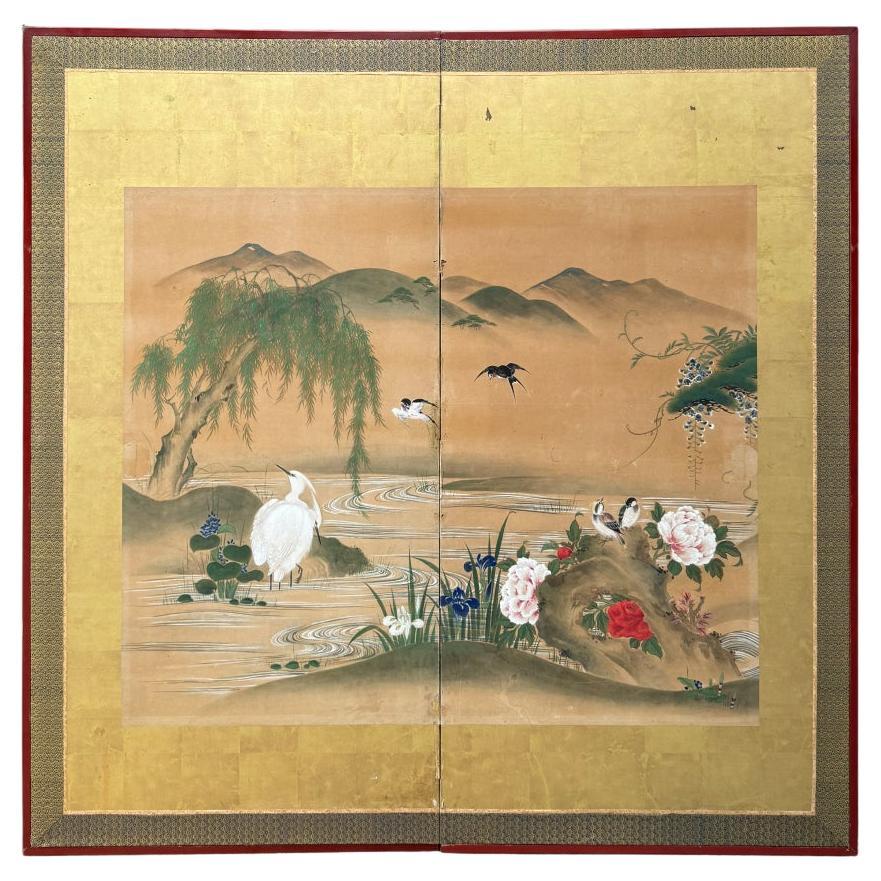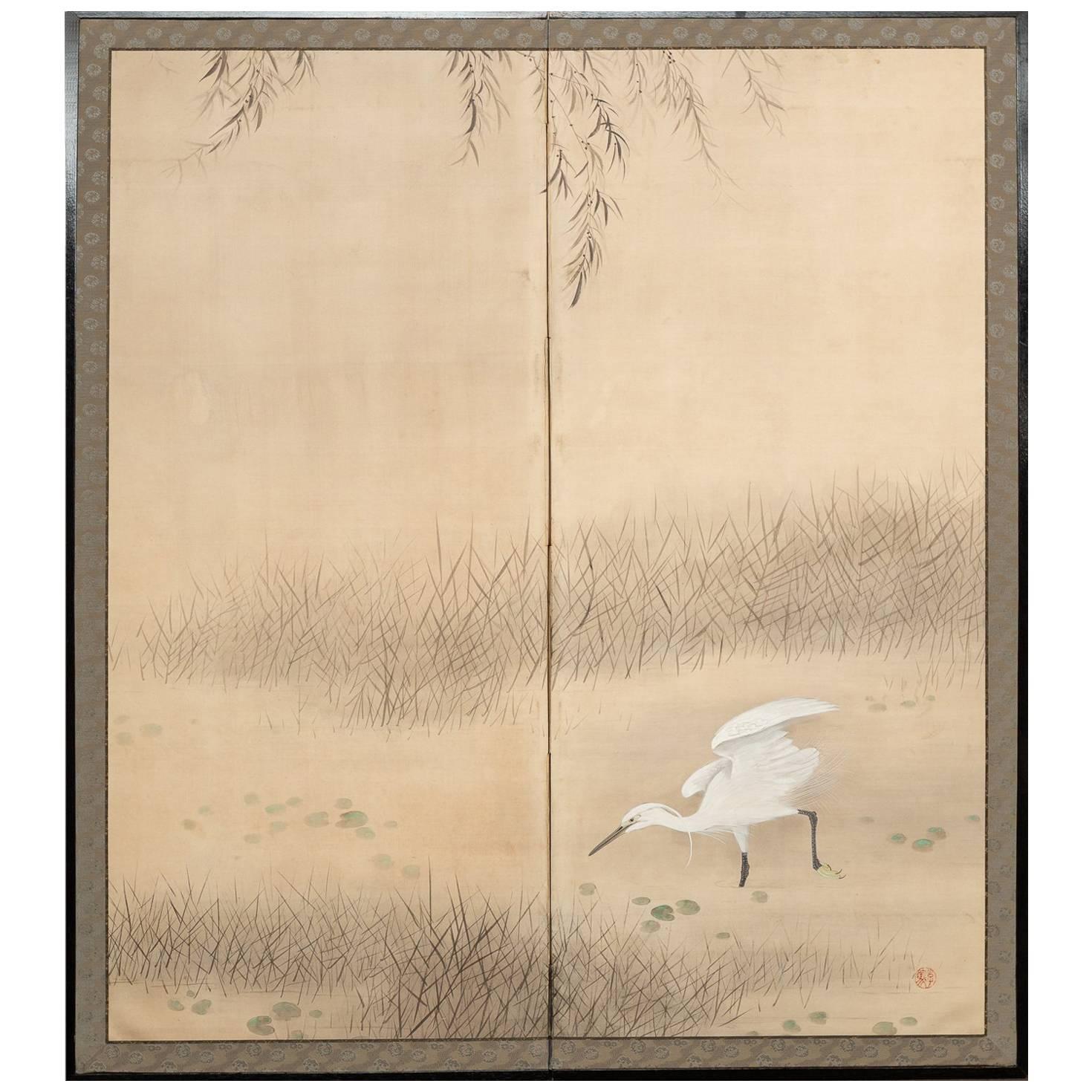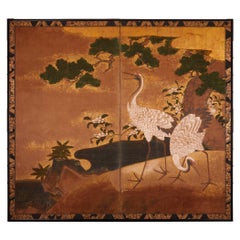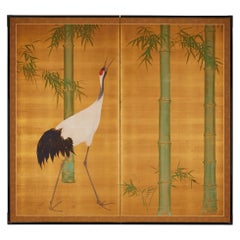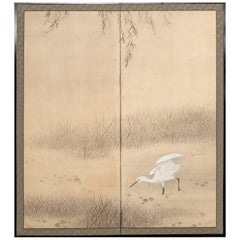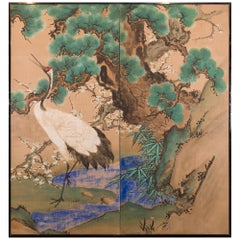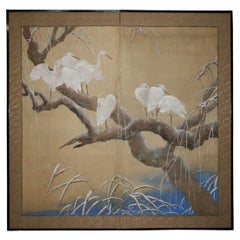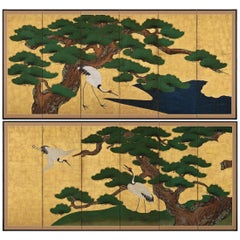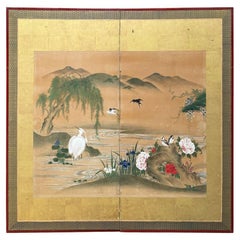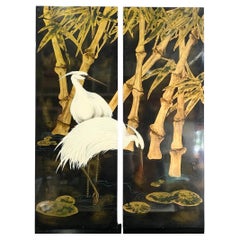Items Similar to Japanese Two-Panel Screen: Egrets in Japanese Red Pine with Gold Ground
Want more images or videos?
Request additional images or videos from the seller
1 of 10
Japanese Two-Panel Screen: Egrets in Japanese Red Pine with Gold Ground
$28,750
£21,597.80
€24,905.78
CA$39,894.38
A$44,331.45
CHF 23,230.15
MX$543,646.23
NOK 296,287.04
SEK 278,735.97
DKK 185,886.16
Shipping
Retrieving quote...The 1stDibs Promise:
Authenticity Guarantee,
Money-Back Guarantee,
24-Hour Cancellation
About the Item
Seven graceful Egrets perched upon very vibrant pine. Representing strength, luck, and longevity. A harmonious balance in nature. Mineral pigments on Mulberry paper with dark brown lacquer trim. Artist seal reads: Hakuzen.
- Dimensions:Height: 70 in (177.8 cm)Width: 69.5 in (176.53 cm)Depth: 0.75 in (1.91 cm)
- Materials and Techniques:
- Place of Origin:
- Period:
- Date of Manufacture:c.1880
- Condition:Condition report upon request.
- Seller Location:Hudson, NY
- Reference Number:Seller: S19011stDibs: LU855132200362
About the Seller
5.0
Recognized Seller
These prestigious sellers are industry leaders and represent the highest echelon for item quality and design.
Established in 1971
1stDibs seller since 2008
166 sales on 1stDibs
Typical response time: 17 hours
Associations
The Art and Antique Dealers League of AmericaAntiques Associations Members
- ShippingRetrieving quote...Shipping from: Hudson, NY
- Return Policy
Authenticity Guarantee
In the unlikely event there’s an issue with an item’s authenticity, contact us within 1 year for a full refund. DetailsMoney-Back Guarantee
If your item is not as described, is damaged in transit, or does not arrive, contact us within 7 days for a full refund. Details24-Hour Cancellation
You have a 24-hour grace period in which to reconsider your purchase, with no questions asked.Vetted Professional Sellers
Our world-class sellers must adhere to strict standards for service and quality, maintaining the integrity of our listings.Price-Match Guarantee
If you find that a seller listed the same item for a lower price elsewhere, we’ll match it.Trusted Global Delivery
Our best-in-class carrier network provides specialized shipping options worldwide, including custom delivery.More From This Seller
View AllJapanese Two-Panel Screen: Cranes on Gold
Located in Hudson, NY
Early Kano School painting of pine trees overlooking two beautifully painted cranes and floral design in a natural setting by water’s edge. Mineral pig...
Category
Antique Late 18th Century Japanese Paintings and Screens
Materials
Gold, Gold Leaf
Japanese Two Panel Screen: Bamboo and Manchurian Crane
Located in Hudson, NY
Kano style painting in mineral pigments on silk with a silk brocade border.
Category
Early 20th Century Japanese Paintings and Screens
Materials
Brocade, Silk
Japanese Two Panel Screen, Heron In Water Lily Pond Under Willow
Located in Hudson, NY
Japanese Screen painted with Heron In Water Lily Pond Under Willow. Meiji period (1868 - 1912) painting of a heron at pond's edge. Painted in min...
Category
Early 20th Century Japanese Meiji Paintings and Screens
Materials
Wood, Paper
Japanese Two Panel Screen Manchurian Crane and Turtles
Located in Hudson, NY
In Japan, cranes symbolize fidelity as they mate for life and turtles symbolize longevity. Additionally, this screen also has the Japanese motif of sho-chiku-bai, or the three friends of winter (pine, plum, and bamboo). So called the three friends of winter because all three flourish during the cold months. This screen was originally fusuma doors...
Category
Antique Mid-19th Century Japanese Edo Paintings and Screens
Materials
Paper
Japanese Two Panel Screen: Water Fowl by River's Edge
Located in Hudson, NY
Japanese Two Panel Screen: Water Fowl by River's Edge, Showa period (1926 - 1989) painting of fowl on a river bank. Very art deco in style. Painted in min...
Category
Early 20th Century Japanese Showa Paintings and Screens
Materials
Silk, Wood, Paper
Japanese Two Panel Screen Amorous Cranes and Turtles
Located in Hudson, NY
Japanese two panel screen: Amorous Cranes and Turtles. In Japan, cranes symbolize fidelity as they mate for life and turtles symbolize longevity. Additionally, this screen also has the Japanese motif of sho-chiku-bai, or the three friends of winter (pine, plum, and bamboo). So called the three friends of winter because all three flourish during the cold months. This screen was originally fusuma doors...
Category
Antique 1850s Japanese Edo Paintings and Screens
Materials
Wood, Paper
You May Also Like
Japanese Two-Panel Screen with Snow Cranes on a Willow Tree, 19th C
Located in New York, NY
This great masterpiece is one of the most amazing screen paintings we have seen, each snow crane is painted with its own personality and attitude, using the finest pigments and Gofun...
Category
Antique 1860s Japanese Japonisme Paintings and Screens
Materials
Brocade, Wood
Circa 1700 Japanese Screen Pair, Cranes & Pines, Kyoto Kano School
Located in Kyoto, JP
Pines and Cranes
Anonymous. Kyoto Kano School.
Late 17th/early 18th centuries, circa 1700.
Pair of six-panel Japanese folding screens.
Ink, gofun, pigment and gold leaf on paper.
This bold composition presents two pine trees extending to the left and right across a gold leaf background. One tree is silhouetted against a green ground, golden clouds obscuring its true size, the other stretches across a stylized waterway. The pines are paired with Manchurian cranes with red crests and snow white plumage. Both have been highly auspicious motifs in East Asia since Chinese antiquity. Here the artist utilized fluid and instinctive ink brushstrokes to define the trunk, branches and tail feathers, in strong contrast to the precision and sharp angularity of the crane’s legs and beaks. The adoption of this vast metallic painting support required an unerring sense of design and composition, so that the negative space surrounding motifs could imply context for the otherwise floating pictorial elements. The brushwork detailing the trunks of the pines, the exaggerated dimensions of the pine trees and the strength and dynamism of the composition are all reminiscent of Kano Eitoku...
Category
Antique Late 17th Century Japanese Edo Paintings and Screens
Materials
Gold Leaf
Meiji periof Nature scene with herons
Located in Fukuoka, JP
Meiji periof Nature scene with herons
Peroid: Meiji
Size: 154 x 155 cm (60.6 x 61 inches)
SKU: SD224
The artwork showcases a serene natural landscape that harmoniously blends vario...
Category
Antique 19th Century Japanese Meiji Paintings and Screens
Materials
Wood, Paper
Chinese Hand Painted Egrets Wading Amongst the Trees on Wooden Board - 2 Pieces
Located in Delray Beach, FL
Transform your space with these stunning Chinese hand-painted wooden panels featuring egrets wading amongst trees. This set of two panels captures the serene beauty of nature through...
Category
Vintage 1980s Chinese Paintings
Materials
Wood
19th Japanese Screen with Cranes and Pine on a Golden Background
Located in Marbella, ES
Stunning four-panel Japanese screen decorated with a traditional scene of cranes and a majestic pine tree on a gold background. The painting technique highlights the details of the b...
Category
Antique 19th Century Japanese Paintings and Screens
Materials
Gold, Iron
Japanese Meiji Two Panel Screen Geese and Reeds
Located in Rio Vista, CA
Fantastic Japanese late Meiji period two-panel byobu screen by Hashimoto Koshu. The large screen features two white geese amid brightly colored reeds. The symbolism of geese and reeds was introduced to Japan from China in the 13th century. This was a popular subject for Japanese zen artists of the period. Beautifully crafted with exceptional brush strokes and details. Made with natural pigments in dramatic vivid colors of white, pink, and mint green on a silk background of gilt. Circa 1900 with artist seal on bottom right corner. Koshu studied Western art under...
Category
20th Century Japanese Meiji Paintings and Screens
Materials
Silk, Wood, Paper
More Ways To Browse
Red Japanese Furniture
Japanese Lacquer Panels
Antique Japanese Seals
Painting Antique Pine Furniture
Japanese Antique Gold Screen
Lacquered Red Screens
Japanese Lacquer Panel Screen
Antique Japanese Lacquer Screens
Japanese Screens Pines
19th Century Japanese Lacquer Screen
Egret Japanese
Japanese Lacquer Panels
Antique Japanese Seals
Antique Japanese Silk Screen
18th Century Chinese Painting
Japanese Wall Screen
Pair Of Chinese Paintings
Japanese Paper Scroll
